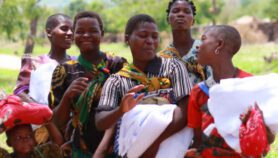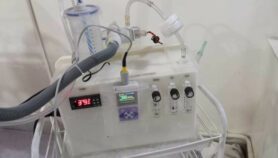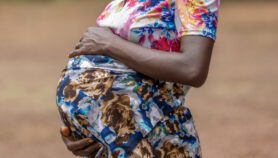31/01/22
Tackling the stigma around birth defects in Africa

By: Royal Uche
Send to a friend
The details you provide on this page will not be used to send unsolicited email, and will not be sold to a 3rd party. See privacy policy.
Stigma around birth defects still plagues those with Down syndrome and their families in Africa, writes Royal Uche.
[LAGOS] Cynthia Solomon, a 45-year-old businesswoman in Nigeria, started having issues in her matrimonial home when she gave birth to two children with Down syndrome.
“I was shattered and heartbroken. I know I will live with the fact that there is no cure for Down syndrome but what broke my heart is the way and manner my family members and people in my community treated us,” says Solomon. “At a point, they stopped speaking to me as I was labelled a witch.”
About 295,000 newborns die within 28 days of birth every year worldwide because of congenital malformations, or birth defects, the most common being Down syndrome, heart defects, and neural tube defects. About 94 per cent of these occur in low- and middle-income countries, according to the WHO.
Although 50 per cent of congenital malformations have no known causes, issues such as anomalies in genes, alcohol or tobacco during pregnancy and inadequate access to nutritious food by pregnant women have been linked, the WHO says.
But in low- and middle-income countries, myths and misconceptions about birth defects abound.
A study of congenital malformation (CM) conducted in Ethiopia among 40 participants and published by PLOS ONE in November 2021 shows the extent of the myths and misconceptions.
“I am used to the way people treat [stigmatise] me in public but my children who are nine and 11 years old sometimes cry.”
Cynthia Solomon
“The majority of the respondents stated that most of the society believed that the causes of CMs were punishment by God due to estrangement from God or sins committed by affected children’s parents or families considered as cursed and evildoers by the community,” study said. “Almost all participants said that raising a child with a major CM was very difficult. About half of their belief in CM were traditional and resulted from poor awareness.”
Impact of poor awareness
Such poor awareness also negatively impacts parents such as Solomon and their children as they become stigmatised in their communities.
“I am used to the way people treat me in public but my children who are nine and 11 years old sometimes cry. My prayer is that the world will one day accept them the way they are,” says Solomon.
Tola Makinde, the founder and executive director of the Moyinoluwa Rainbow Foundation, a non-profit organisation in Nigeria that supports families and children living with Down syndrome, tells SciDev.Net that myths and misconceptions further compound the stigmatisation and rejection experienced by parents raising children with CMs.
“Due to the stigmatisation, many parents give up on their child, see it like they are wasting their time and resources and sometimes wish the child away or dead. Some fathers walk away from their homes, calling their wives or their children names,” Makinde explains.
But Ifeoluwa Odunyemi, a working mother in her late 30s, tells SciDev.Net that her son with Down syndrome is well accepted by her nuclear family. “Society needs to understand that he is a child, just like every other child before looking at his disability,” she says.
“I also plead with the government to have compassion on parents raising children with congenital malformations. They can do that by ensuring that they build more intervention centres so that our children can be integrated into the society, and drugs for CMs children should be subsidised.”
Makinde said she was depressed when she found out that her daughter, Moyinoluwa, had Down syndrome.
“Five days after I gave birth to her, the doctors confirmed a diagnosis of Down syndrome. It was a rude shock. I was in denial initially and did not want to believe it as I had prior knowledge about Down syndrome and its lifelong challenges. I thought about the reality, the pain, sacrifices, the trauma and the society plagued with ignorance,” Makinde tells SciDev.Net.
Changing the narrative
Makinde says that, as an ambassador for Save Down Syndrome Inc, her goal is to minimise the stigmatisation faced by children living with such disorders, and end the mistreatment and abuse of those affected in Africa.
As well as advocating for specialist health facilities and schools, Makinde says: “Building early intervention centres would also reduce the stigma and denial while organising capacity building programmes for affected people, their families, health personnel and educators. Companies should employ them as ways to support them.”
“There should be constant sensitisation of congenital malformations and, intending mothers should be educated on the modifiable and non-modifiable causes of birth defects.”
Moruf Abdulsalam, Lagos State University Teaching Hospital Lagos, Nigeria
She urges parents not to lock up their children with CMs because of the prejudice they face. “Instead, I encourage parents and caregivers to bring them out and ensure they have the best care,” she adds.
Prevention, the next step
Moruf Abdulsalam, a consultant paediatric surgeon at the Lagos State University Teaching Hospital Lagos, Nigeria, says the disproportionate burden of severe congenital malformations in low- and middle-income countries stem from multiple factors.
“[These] include higher birth rates in low- and middle-income countries, low screening for congenital malformations, abortion law that prevents women from aborting a baby if a severe birth defect is detected and week health system to detect, manage and support families with birth defects among others,” Abdulsalam says.
He explains that high-income countries have low birth rates, whereas in low- and middle-income countries like Nigeria there is no such thing. Here, he says the fertility rate is 5.32 births per woman, leading to a higher likelihood of birth defects.
Abdulsalam said CMs can be prevented where there are modifiable causes such as nutritional, occupational and environmental factors, adding that some causes are genetic and are not modifiable.
“Also, policymakers must, as a matter of urgency, fortify the health system to be able to do genetic screening and improve surveillance [and] early detection. More importantly, there should be constant sensitisation of congenital malformations and, intending mothers should be educated on the modifiable and non-modifiable causes of birth defects.”
To help children with CM, the consultant says family and societal support is key, adding that “policymakers should include the treatment of congenital malformations in the [health] insurance policy, to take off the burden of out of pocket expenses for the family. Families can join NGOs who support and promote the care of such congenital malformations.”This piece was produced by SciDev.Net’s Sub-Saharan Africa English desk.













